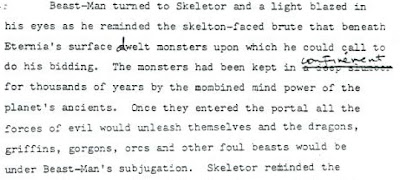 |
| Masters of the Universe Preview, 1982, Artist: Curt Swan and/or Dave Hunt |
When most people think about the He-Man mythos (assuming they think about it at all) they recollect the 1983 Filmation series, but the Masters of the Universe had a history before the series – one with significant differences from what would become 'official' canon.
When He-Man was just an action figure, mini-comics accompanied MOTU merchandise. Although called mini-comics, the early ones were more like mini-story books, with a single graphic covering most of each page and a few lines of text beneath. Regardless, the point was to provide the basis of play – a narrative stage that established a fictional environment, the identities of the characters, and the ways in which they interacted. Alfredo Alcala was the artist for the first series of mini-comics and Don Glut was the author. Glut is a man with a variety of talents and interests. Listing his many creations is beyond the scope of this post; however, as an example of his inventiveness, allow me to say he is the person responsible for Tragg and the Sky Gods (among other Gold Key titles).
 |
| “They will add to your strength, use them wisely...” |
 |
| Note the golden unicorn fighting Skeletor |
 |
| “...magic fires, created by ancient scientists and sorcerers...” |
In 1982, still prior to the Filmation series, DC Comics published actual MOTU comic books. These were written by Paul Kupperberg who (along with Jan Duursema) created Arion, Lord of Atlantis prior to scripting the MOTU comics. At the time, Arion was your humble host's favorite title. Alas, it was Kupperberg who implemented the idea of Prince Adam as He-Man's “secret identity.” Keep in mind that Kupperberg's version of Adam had incredible strength.
So, He-Man is a blond, incredibly strong dude with a Dutch boy hairstyle and Prince Adam is a blond, incredibly strong dude with a Dutch boy hairstyle. You would think that people would be suspicious. Oh wait, Prince Adam has a cowardly green-and-yellow tiger who talks while He-Man has a courageous green-and-yellow tiger who talks. Yeah, I guess that's enough to throw off anybody. Another thing I dislike about Kupperberg's Eternia is the technological disparity between the aristocracy and the peasants. To my knowledge, Skeletor never capitalized on this.
In late 1982, Mattel approached Michael Halperin to write a 'bible' for the Filmation series. Halperin came up with the good idea of Adam/He-Man's mother being an astronaut from Earth, but not all of Halperin's ideas became canon. In Halperin's story, Evil-Lyn, Beast Man, and Tri-Klops were originally 'normal' Earth humans (and Beast Man's name was Biff – no lie).
If there was any one thing that ruined MOTU for me, it was Orko. I appreciate the 'need' for a comic relief character, but why Orko? I'd rather have Gwildor. For that matter, a dozen Trobbits would be preferable to Orko. It is Halperin we have to thank for Orko; however, in Halperin's bible he's called “Gorpo,” which is a more fitting name I think.
Halperin seems to have been familiar with D&D.
Where else would he get 'quasit' from? Halperin also includes dwarves, trolls, gnolls, manticores, wyverns, basilisks, and giant centipedes in his bible. In the following passage, we are told that Beast Man can supposedly control orcs.
Orcs (or at least creatures called orcs) appear in one of the later mini-comics.
 |
| “Orcs” in masks. Can you tell they're evil? |
Skeletor doesn't use this ability often enough in my opinion.
 |
| Skeletor, “Dark Lord,” channels Darth Vader |
















